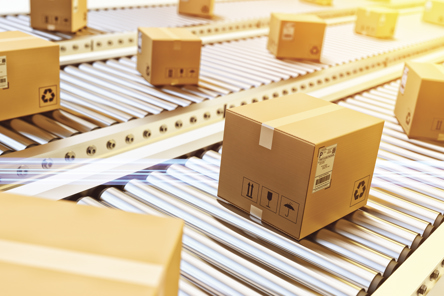According to Insider Intelligence, the ecommerce industry is set to hit $6.3 trillion in 2023 and will continue to increase to $8.15 trillion by 2026. Many companies are implementing digital transformations and ecommerce strategies to take advantage of this growing trend in online shopping.
Rising competition in the digital marketplace makes it essential for companies to develop a winning ecommerce order fulfillment strategy. An efficient and streamlined approach to your ecommerce logistics helps keep your customers from jumping ship to competitors.
Companies also face problems in global supply chains. CNBC reports that many supply chain managers expect problems to continue through 2024. This article reviews the best ecommerce order fulfillment practices to help you optimize your logistics and stay ahead of the competition.
WHAT ARE THE BEST STRATEGIES FOR ECOMMERCE ORDER FULFILLMENT?
Order fulfillment is a critical component of the ecommerce process. It involves receiving, processing and delivering a customer's order. Efficient order fulfillment processes ensure that your customers receive their orders on time, in good condition and with minimal errors. This helps you build customer loyalty and maintain a positive brand image. Here are eight of the best strategies you can use to help improve your ecommerce order fulfillment process and provide a better customer experience.
DESIGN AN EFFICIENT ECOMMERCE ORDER FULFILLMENT PROCESS
The goal should be to create a seamless process for receiving, processing and delivering orders while minimizing errors and delays. To remain competitive, you must deliver a customer's order within 1-2 business days. Proper inventory management, streamlined order processing and fast delivery methods play key roles in making your ecommerce logistics efficient.
INTEGRATE A RELIABLE INVENTORY MANAGEMENT SYSTEM
A reliable inventory management system helps you keep track of stock levels and ensures products are available for purchase. This allows you to promptly fulfill a customer’s order or communicate out-of-stock items with real-time updates.
SEKO Logistics has developed three in-house technology platforms: MySEKO, SEKO 360 and SEKO IMS. These industry-leading ecommerce logistics solutions can help you optimize your demand chain, warehouse or inventory management.
OFFER VARIOUS SHIPPING METHODS
When selecting shipping and delivery methods for your ecommerce order fulfillment process, prioritize options that balance speed and cost-effectiveness. Ensure customers can track their orders and receive delivery confirmation, even if they are not present to receive the package in person.
You can also offer various shipping options, including expedited delivery. This allows you to cater to various customer needs and provides opportunities for upselling customers with faster delivery times.
COMMUNICATE WITH YOUR CUSTOMERS
Keeping customers informed about the status of their orders is essential to building trust and loyalty. In fact, “Porch Pirates” - those who steal packages off one’s front step of their home - stole an estimated 260 million packages in 2022, according to CNBC.
For this reason, you should provide customers with shipping and tracking information to tell them when to expect delivery. This allows them to plan their schedules accordingly and reduce customer support inquiries about their order’s status.
This can be especially important when delivering high-value products like electronics, jewelry or banking documents. A clear communication process from processing to delivery gives your customers peace of mind about their orders.
SCALE WITH A THIRD-PARTY LOGISTICS PROVIDER
A third-party logistics (3PL) provider offers businesses the ability to scale their operations as demand changes without investing in additional resources. 3PLs also provide logistics expertise in ecommerce shipping to help your business streamline operations and reduce costs. If you ship products internationally, SEKO can provide global end-to-end logistics solutions for your ecommerce brand.
CREATE A SIMPLE RETURN PROCESS
Establish a straightforward and convenient return process for your customers and consider offering free returns. In addition to returns, design a system for exchanges to keep customers engaged with your business rather than a competitor. Addressing any issues that may arise with customer orders efficiently creates a positive perception of your company with your customers.
ADOPT AUTOMATION—FAST
McKinsey states that companies who quickly adopt A.I. in their supply chain management can improve logistics costs by 15 percent, inventory levels by 35 percent and improve service levels by 65 percent compared to companies who adopt it more slowly.
You should consider automating two areas: ordering processing and warehouse inventory management. Automating order processing helps streamline order tracking and shipping label generation. Automation software for warehouse inventory management enables you to track inventory, manage stock levels and monitor order fulfillment.
FIND WAYS TO IMPROVE
Conduct regular performance evaluations of your ecommerce order fulfillment process to identify areas for improvement. This can include tracking key performance indicators (KPIs) such as order fulfillment accuracy, order processing time and customer satisfaction. Conduct surveys, read customer reviews and analyze the feedback. This can give you valuable insights into your customer’s experience and gauges the efficiency of your ecommerce order fulfillment process.
HOW CAN I OPTIMIZE MY SUPPLY CHAIN FOR ECOMMERCE?
Streamlining supply chains helps reduce the time and cost associated with producing, storing and shipping products to customers. An optimized supply chain also allows your ecommerce business to respond quickly to changes in consumer demand and adapt to evolving market conditions. This can lead to improved delivery times, better inventory management and fewer mistakes in your supply chain.
For example, Amazon invested in automated warehouses and robots, implemented advanced analytics to optimize its logistics network and used data-driven decision-making to improve inventory management.
In 2004, Walmart invested $500 million in RFID (Radio-Frequency Identification) and automated systems to track inventory levels in real time. These technologies allow both Amazon and Walmart to quickly identify and restock items running low, reducing out-of-stock situations.
It can be a complex process, but with the right strategies, your business can streamline its operations, stay competitive and grow your market share.
5 WAYS TO OPTIMIZE YOUR SUPPLY CHAIN FOR ECOMMERCE
- Build Strong Supplier Relationships: This can involve communicating regularly with suppliers, working with them to improve lead times and collaborating on new product developments.
- Forecast Demand: Use a combination of statistical forecasting, collaborative forecasting and machine learning to make accurate predictions about future demand.
- Inventory management: Use data and analytics to track customer demand and adjust inventory levels accordingly to ensure products are readily available for purchase.
- Third-party Logistics: Partner with a third-party logistics (3PL) provider to help with the storage, packaging and shipping of your products. This can help to reduce costs and increase efficiency.
- Consolidate Shipments: Leverage software to optimize routes and delivery schedules to reduce transportation costs.
WHAT ARE THE BENEFITS OF USING A THIRD-PARTY LOGISTICS PROVIDER FOR ECOMMERCE?
We know what you’re thinking. Amazon and Walmart are massive companies with the resources to invest in innovative technologies and optimized fulfillment services. That’s where a third-party logistics (3PL) provider comes in.
3PL providers have become increasingly popular among businesses looking to expand their ecommerce logistics. They can offer warehousing, order management and ecommerce fulfillment services.
Outsourcing these tasks to a 3PL allows you to focus on growing your business while leaving supply chain management to the experts. See below to discover the main benefits of partnering with a 3PL provider.
THE 10 MAIN BENEFITS OF PARTNERING WITH A 3PL PROVIDER:
- Reduced Operating Costs: Partnering with a 3PL provider can lower costs related to securing warehouse space, transportation and other ecommerce logistics operations.
- Scalability: Respond to fluctuations in the market by increasing warehouse space during peak seasons or decreasing inventory during slower periods.
- Logistics Expertise: Leverage a 3PL provider’s specialized knowledge in logistics and supply chain management to optimize your company’s operations.
- Efficiency: A 3PL provider can improve efficiency in your logistics operations and lead to faster delivery times.
- Customizable Services: 3PLs offer various ecommerce logistics solutions, enabling you to select the services that best meet your needs.
- Increased Capacity: Additional resources like warehousing, transportation and inventory management allow you to handle a more significant order volume and increase profits.
- Risk Management: 3PL providers can help companies manage risk by transferring specific responsibilities and liabilities.
- Proprietary Technology: Gain access to the latest technologies and software to automate your ecommerce logistics processes and improve supply chain visibility.
- Improved Customer Experience: Providing faster delivery times and more accurate tracking information results in an improved customer experience.
- Competitive Advantage: 3PL providers can assist companies in responding quickly to customer demand, giving them a competitive edge.
WHAT ARE THE CHALLENGES OF GLOBAL ECOMMERCE LOGISTICS?
Global ecommerce logistics is a complex and challenging process that requires a deep understanding of international trade regulations, customs procedures and logistics networks. It also requires managing risks such as currency fluctuations, language barriers and cultural differences. Dealing with different time zones, shipping methods and carrier networks can make coordination and communication difficult. Here are the six main challenges for ecommerce logistics regarding global end-to-end logistics.
6 CHALLENGES FOR GLOBAL ECOMMERCE LOGISTICS:
- Supply Chain Disruptions: The worldwide supply chain is facing a lot of challenges, including labor shortages and political instability. As a result, 43% of companies are modifying their shipping plans to minimize the effect of global shipping delays.
- Complex Regulations and Compliance Requirements: Navigating diverse regulations for importing and exporting goods across countries can pose a challenge for your ecommerce company in terms of compliance.
- Long Shipping Times and High Shipping Costs: International shipping can be a significant obstacle for your eCommerce business due to the longer shipping times and higher costs than domestic shipping.
- Lack of Visibility and Control: International shipping reduces visibility and control over the supply chain. This makes it harder for you to track and manage your inventory.
- Cultural and Language Barriers: Different cultures and languages can make communication with your customers and partners more challenging.
- Logistics Infrastructure: Logistics infrastructure may be less developed in certain countries. This makes it difficult for you to quickly and efficiently deliver goods to customers.
PARTNER WITH A 3PL WITH GLOBAL END-TO-END LOGISTICS
In today's global economy, expanding your ecommerce business internationally is crucial for success. SEKO can offer you global end-to-end logistics to help you overcome the challenges of international shipping, customs and compliance.
Our global transportation network can help you reach new customers, increase efficiency and reduce errors in your order ecommerce fulfillment process. Our advanced technology platform can also help you build more accurate data models while increasing productivity across your ecommerce order fulfillment process.
Partner with SEKO to enjoy greater visibility and increase control over your supply chain. If you are ready to expand your business globally, get in touch with our team today.





